REAL-TIME 3D ANIMATION CONTROL WITH MOVIESANDBOX AND ARDUINO.
– April 25th, 2011
Friedrich posted a nice example of real-time animation control usingMoviesandbox and Arduino. Two sock-puppet bend sensors (connected to the computer via Arduino) control the movement of the mouths of the digital characters in real-time, allowing for live performance and expressive control by the human puppeteers. As Friedrich and Jake talk, we see their words being mouthed by the on-screen fish. There’s even a real-time depth-of-field filter (Gaussian blur) being applied to give an aquarium feel to the rendering. Overall, it’s a great example of using Arduino for continuous, real-time control over a 3D animation.
Moviesandbox is a new open-source tool for real-time 3D animation, with or without physical control and input. It allows you to sketch 3D models using drawing tools, then add a skeleton (bones) for animation control. You can even import data from the Kinect!
For more information about Moviesandbox, check out the tutorials page or FAQ.
Finally, please consider supporting the development of Moviesandbox on Kickstarter. Friedrich would like to dedicate the next two months to full-time development on Moviesandbox, and your support would be a big help.
SWEDISH NY TEKNIK ABOUT ARDUINO
– April 23rd, 2011
In just one day (April 20th) the Swedish magazine Ny Teknik published three different notes about Arduino. First they told the story of the platform and compared it to others in terms of price, simplicity of use, etc. Second they interviewed me about the plans we have for the future … I didn’t tell the secrets, you will have to follow this blog to know more. And third they launched a contest where you can win a whole Arduino starter kit.
GOODBYE INDIA
– April 22nd, 2011
I am about to start packing before leaving India to go back home. I have spent three weeks as a visiting researcher at IIITB (International Institute of Information Technology – Bangalore) located at Electronics City, just in front of Infosys. During these three weeks I have got to see a version of India a little different from the one many Europeans have. I didn’t come as a tourist, I came to meet professors, researchers, hackers, coders, etc. I also came to write a chapter of my PhD about how to characterize Arduino users (more on this in some months).
During the time here I have been looking at technology, development, entrepreneurship, education … I was a keynote at HCI India – a conference about the importance of human factors when designing technology -, but also had a presentation at Jaaga – the cultural space in central Bangalore -, Srishti School of Arts, Design and Technology, and at Indian Coffee House in Delhi.
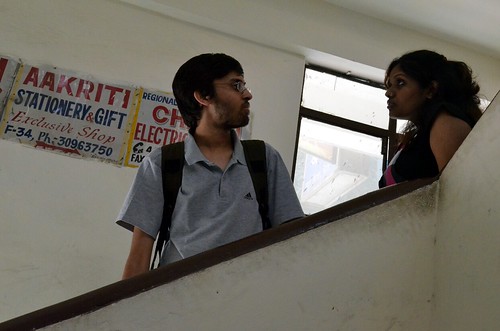
9circuits from Delhi, by D. Cuartielles
Everywhere I went I found people interested in open source technologies, Arduino, Android, Processing, Linux … On April 12th I made a lecture at Srishti School of Arts, and entered in contact with Anders, former student to Tom Igoe, that runs the Toy Lab. The Master students presented their work in the courses they make with Victor Viña with whom I have been meeting before in Barcelona and Malmo. From a conceptual point of view, the Srishti students are very similar to any other design students in Europe, US, or Korea, which are places where I have been teaching at, so are they when it comes to play with technology.
When it comes to the Arduino community in Bangalore, thanks to Kiran Jonnalagadda (also known as the Hasgeek Guy) who arranged a talk on April 15th at Jaaga, I got introduced to a lot of nice people making projects in their spare time using Arduino. From wiimote controlled robots, to Android-to-Arduino connections, passing by irrigation systems (the cool thing about this last project is that the guy with the idea, Sriram, is just 12 years old).
I have to thank Freeman Murray for his hospitality, and all his crew and visiting artists at Jaaga. They will be moving location soon, hopefully to a place with less coconut trees, I was attacked by one just at Jaaga’s entrance 
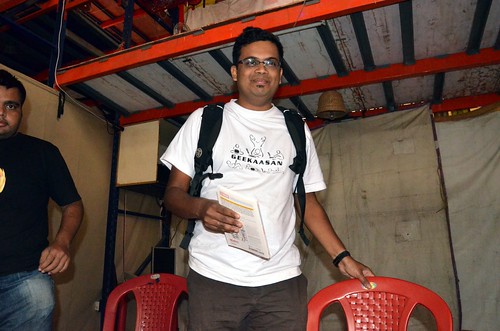
Kiran, the Hasgeek Guy, by D. Cuartielles
Early in the morning of April 16th I took a flight to Delhi were Priya, Miss 9circuits, introduced me to her team there and guided me through the local electronics market. I learned that IIT-Delhi has a group of students called Technocracy dedicated to arrange talks and workshops around robotics, electronics, science in general. I also got to know that 9circuits ambition is creating a hackerspace to channel those energies beyond the university. They are moving to a much bigger space and will be having more than 5 interns working with them in just a couple of weeks. The core team at 9c is 3 people, but at an informal gathering at Indian Coffee House I could count up to 7 people! They are concentrating in building community at local level and want to bring open source tools to education centers around their area.
Back to Bangalore, on April 19th I was invited to visit Ram and his people atTenet. They have a fairly big location from where they arrange workshops for colleges, design new PCBs (they do have a fairly large collection of shields coming out soon), and host students needing a nice workspace with internet connection where to build their projects. I think they have a pretty good vision when it comes to encouraging the new undergrads and grads into creating new designs. I liked their fish robot, it is not diving yet, but the videos are really promising.
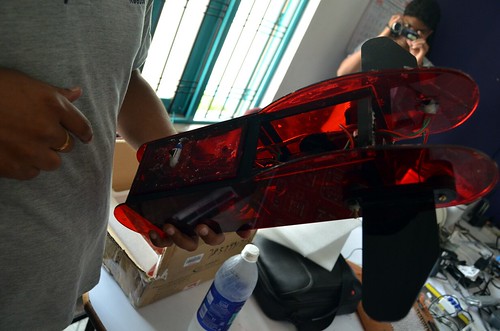
Fish Robot made by Tenet, by D. Cuartielles
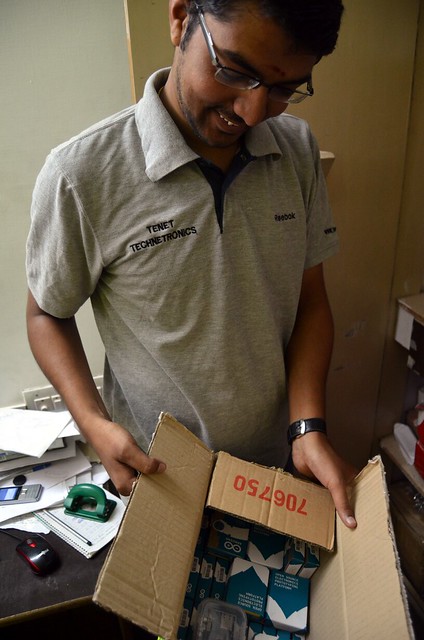
Ram from Tenet, by D. Cuartielles
Prayas, an artist and professor at Srishti, brought me out on April 20th to visit Delhi’s electronics market. It is funny that I am staying at an area called Electronics City, where the only thing I cannot find is a place where to buy resistors. The e-market is about 50min by taxi from the e-city. Together with Prayas I went to the couple of locations where it is possible to purchase Arduino boards directly at a shop. Probably because of how central the market is, it happens to be so much better maintained than the one in Delhi. It is there were I found about the different Arduino compatible boards I spoke about in this article.
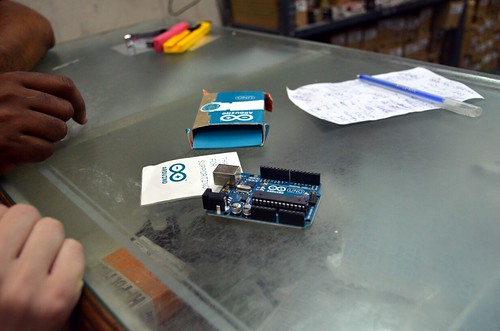
Arduino Uno at Bangalore's Market, by D. Cuartielles
I had plans to visit even more locations, included the National Institute of Design in Bangalore, but my leg is not looking good after the accident with the coconut tree. However, Ram, Priya, and some others have started to look into arranging a workshop tour to Bombai, Delhi, and Bangalore (and maybe somewhere else) for the end of August. It would be great to come and get to know more people in the community here. There is a lot going on, and things are evolving really quick.
And now I should probably just get my luggage ready. Before I leave, I found this in my HDD, a picture of the Arduino USB board I used back in 2005 when I came to India for the first time, I was lecturing about prototyping back then, when the project was barely 3 months old … and my only board had a nasty hardware failure (the USB connector was inverted)
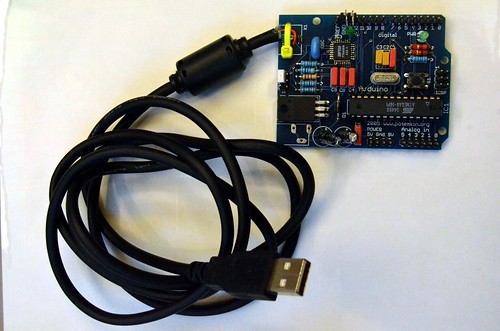
Arduino USB from 2005, by D. Cuartielles
Kiran Jonnalagadda
SUPPORT RADIATION DETECTION HARDWARE NETWORK IN JAPAN
– April 21st, 2011
As lately reported by Arduino blog, there is a common, strong effort to visualize nuclear radiation data. RDTN.org (a collective voice helping others stay informed) kickstarted the enpowerement of the project by purchasing up to 600 Geiger Counter devices. 16 days to go. Support.
RDTN.org is a website whose purpose is to provide an aggregate feed of nuclear radiation data from governmental, non-governmental and citizen-scientist sources. That data will be made available to everyone, including scientists and nuclear experts who can provide context for lay people. In the weeks following launch, it has become evident that there is a need for additional radiation reporting from the ground in Japan. This Kickstarter project will help us purchase up to 600 Geiger Counter devices that will be deployed to Japan. (The project minimum will fund 100 devices). The data captured from these devices will feed into the RDTN.org website and will also be made available for others to use via Pachube, an open-source platform for monitoring sensor data globally. RDTN.org field members will be trained by RDTN.org advisors to properly use these devices. The field members will be required to report to the website 8-10 times per day.
via [Kickstarter] [RDTN.org] see also [Tokyo Hackerspace Geiger Shield] and [Libellium's Geiger Counter]
ARDUINO MIDI RAINBOW
– April 21st, 2011
Last week I was in Rome for the Arduino Day. I was amazed by the projects and the people there: true Arduino fans. This is the first post about some of those projects: more soon.
[anbello] generates – via MIDI – different light patterns on a strip of addressable RGB LED
MIDI messages from the keyboard (real or simulated on PC) enter the MIDI Shield’s MIDI IN and are presented to the Arduino serial port. The Arduino firmware interprets the MIDI messages NoteOn NoteOff, associates each key on the five octaves (60 keys) keyboard to a strip LED and lights it with color associated with the note. In the firmware to control the strip we used theFastSPI_LED library that allows you to address every single LED and turn the desired color (R, G, B).
One interesting thing to note is the use of the firmaware function millis() to implement a sort of elementary multitasking. The idea was taken from this post after user “westfw” on the Arduino forum.
I really appreciate the effort of translating the post. Check the code and part list on [Sululab]
THE POWER OF THE COPY OF THE COPY
– April 21st, 2011
I just published a quick article on my findings in Bangalore, India, about some Arduino compatible boards made as a copy to some other Arduino compatible boards. It is the story of how viral an electronic design with an open license can become.
If being copied is a sign of being into making something right, what does it mean that someone copies the copy of your design?This is the question that I am asking myself since the moment I yesterday discovered people here (Bangalore, India) making copies of copies of Arduino boards. Let me explain this at once: the Arduino boards are cheap for Europeans and Americans, but no matter how cheap the production is in the EU, importing them to India -where I am these days- makes them slightly more expensive to the final user.
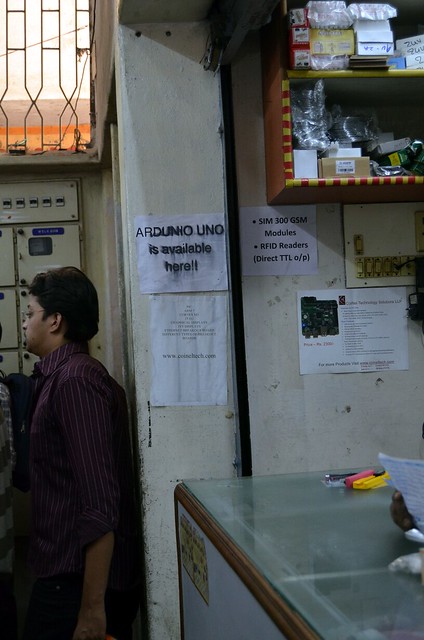
Arduino Uno at Bangalore's Electronics Market
Read the full article at Medea’s Research Blog.
WASHINGTON POST ABOUT BOTTOM-UP INNOVATION AND DIY
– April 19th, 2011

An interesting, well-written portrait about nowadays Maker Revolution from Michael S. Rosenwald on Washington post.
Recent studies show consumers now spend more money tweaking and inventing stuff than consumer product firms spend on research and development. It’s more than $3.75 billion a year in Britain, and U.S. studies under way now show similiar patterns. Makers are even morphing into entrepreneurs, with some of the best projects, including Kleinman’s, raising money for commercial development of self-funding Web sites such asKickstarter, where anyone with a credit card can chip in to back cool ideas.[...]“You think of the lone tinkerer in the shed in the ’50s and ’60s and you were pretty lucky to find anyone else interested in what you were doing,” said Dale Dougherty, the founder of Make Magazine. “Today you begin by putting your work online, and then people can seek you out and help. If you have an idea for a project, there are very few barriers to getting it done.”
via [washington post]
DAVID C. EN BARCAMP CASTELLON
– April 16th, 2011
Para aquellos que aún están en duda de si asistir a la Barcamp Castellón el último fin de semana de Abril. Tengo el placer de anunciar que los organizadores han tenido a bien invitarme y … no he podido resistirme a la tentación de acercarme a la Comunidad x 2 (la Comunidad Valenciana y la Comunidad de Arduino).
La Barcamp se organiza como parte de la iParty 12, que son las Jornadas para la difusión del software libre en Castellón.
Un año más vuelve la iParty, posiblemente la fiesta del software libre más añeja de España. Esta edición, ya van doce, se celebrará los días 28, 29 y 30 de abril y 1 de mayo de 2011 en el pabellón polideportivo de la Universitat Jaume I. Por supuesto, estáis todos invitados.
Como parte del evento, el jueves 28 de Abril habrá un taller de introducción a Arduino de tres horas de duración. Yo estaré presente el sábado 30 y el domingo 31. Voy a traer mi problema del mes en el bolsillo: bootloaders de siguiente generación. Si alguien viene sobrado de vitamina C++, nos sentamos juntos un rato y nos damos una dosis 
Para que la organización esté al tanto de cuantos vamos a ser, es conveniente visitar la web de Jottit donde apuntarse. Para los que sea la primera vez que la usan, arriba a la derecha hay un link para registrarse … el password empieza por “ard” y termina por “uino”, todo en minusculas.
Para preguntas a la organización, se puede seguir el foro aquí.
Ah! y muchas gracias a Jose Manuel Escuder Martinez por el esfuerzo de preparar el evento, choca los 5!

(cc) 2011 High is Five, D. Cuartielles
LIBELIUM’S NEW GEIGER COUNTER
– April 15th, 2011
There are at least three of our distributors working against the clock to create new geiger shields in an attempt to provide people in Japan with tools for self-measuring radiation levels as we have been reporting earlier. Libelium, from Zaragoza, Spain, released one yesterday with one of the most comprehensive guides I have seen so far to how a geiger counter works, how to measure, and how to connect it to an Arduino board.
Libelium’s work in this case could almost be considered political, here their manifesto:
The main finality of the Radiation Sensor Board for Arduino is to help people in Japan to measure the levels of radiation in their everyday life after the unfortunate earthquake and tsunami struck Japan in March 2011 and cause the nuclear radiation leakages in Fukushima. We want to give the chance to measure by themselves this levels instead of trusting in the general advises which are being broadcasted. The usage of this sensor board along with the affordable and easy to use Arduino platform helps people to get radiation values from specific places.As technical guys, we feel the responsibility of providing our support in those areas where we can contribute. As a result, first batch has been shipped to Japan at no charge to the Tokyo Hackerspace and other working groups.The design of the board is open hardware and the source code is released under GPL.The Libelium Team. April 2011.
In parallel to the effort to provide people with Hardware, Shigeru Kobayashi is working in creating a central point of information on where to find sensors, and how to send the information to the net and make it available for the rest of us. We will come back with more information about this soon.
Read more at Libelium’s page, where you can also acquire the sensor.
TOKYO HACKERSPACE/RDTN GEIGER SHIELD
– April 14th, 2011

Japan’s difficoult moment has challenged many Arduino users (I can count at least three different threads on the forum about geiger tube & sensors lately 1,2, 3). As David posted some time ago, the need of an open, net-spreaded visualization of the real level of radioactivity was heavily felt by the community, also for trasparency reasons. This is when the Geiger shield comes in:
This is an Arduino-based geiger counter shield that makes it easy to upload data to the internet and also interchange tubes. Since it’s open source and Arduino-based, its also easy to hack this to other interesting applications.



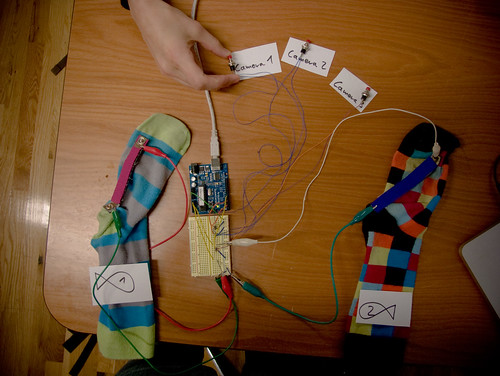









0 comentarios:
Publicar un comentario